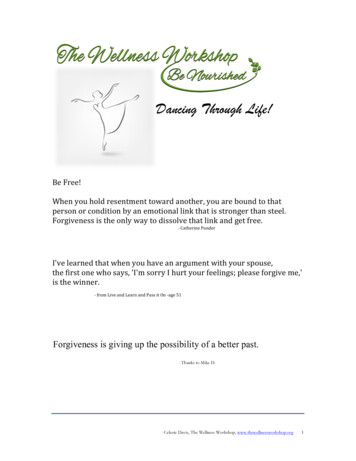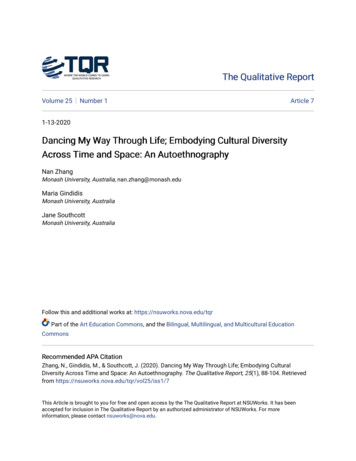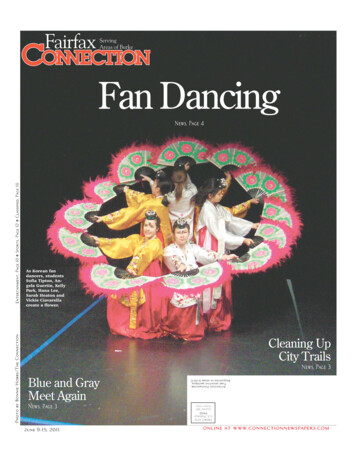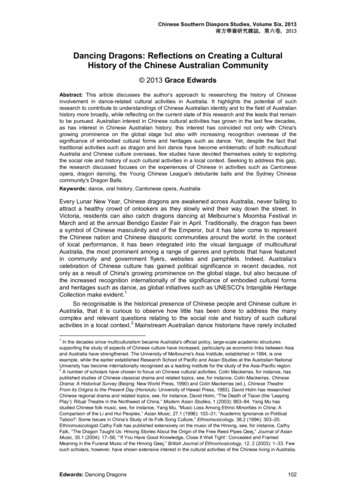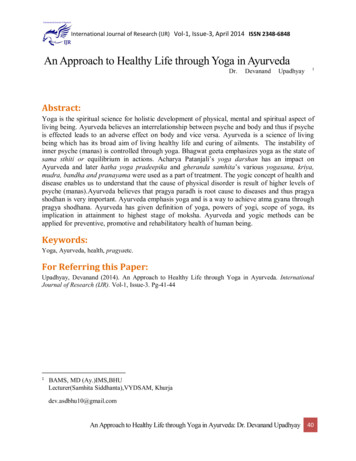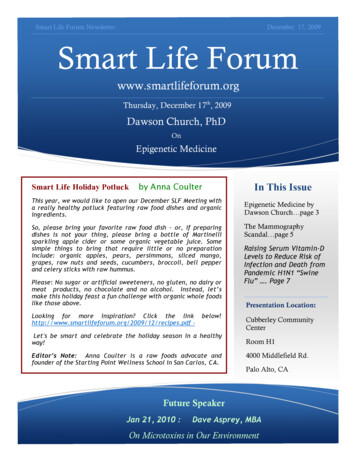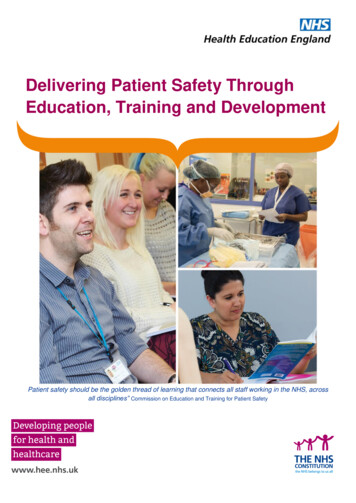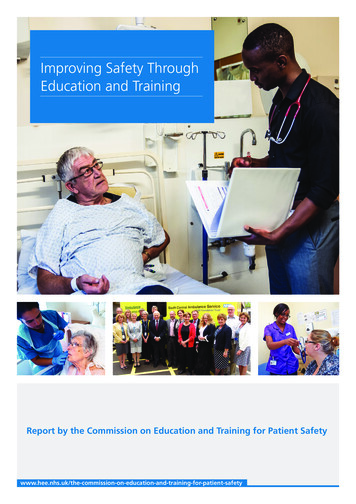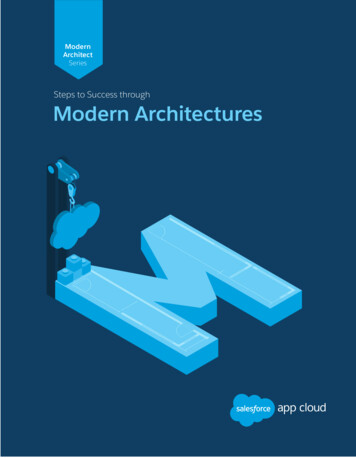
Transcription
http://www.diva-portal.orgPostprintThis is the accepted version of a paper published in Leisure/ Loisir. This paper has beenpeer-reviewed but does not include the final publisher proof-corrections or journalpagination.Citation for the original published paper (version of record):Heikkinen, S. (2021)Dancing through life in a changing world: Life course, historical time and seriousleisureLeisure/ 3Access to the published version may require subscription.N.B. When citing this work, cite the original published paper. 2021 The Author(s). Published by Informa UK Limited, trading as Taylor & FrancisGroup. This is an Open Access article distributed under the terms of the Creative CommonsAttribution-NonCommercial-NoDerivatives License ), which permits non-commercial re-use, distribution, and reproduc-tion inany medium, provided the original work is properly cited, and is not altered, transformed, orbuilt upon in any way.Permanent link to this version:http://urn.kb.se/resolve?urn urn:nbn:se:kau:diva-83353
Leisure/LoisirISSN: (Print) (Online) Journal homepage: https://www.tandfonline.com/loi/rloi20Dancing through life in a changing world: lifecourse, historical time and serious leisureSatu HeikkinenTo cite this article: Satu Heikkinen (2021): Dancing through life in a changing world: life course,historical time and serious leisure, Leisure/Loisir, DOI: 10.1080/14927713.2021.1874833To link to this article: https://doi.org/10.1080/14927713.2021.1874833 2021 The Author(s). Published by InformaUK Limited, trading as Taylor & FrancisGroup.Published online: 25 Jan 2021.Submit your article to this journalArticle views: 179View related articlesView Crossmark dataFull Terms & Conditions of access and use can be found ation?journalCode rloi20
1.1874833Dancing through life in a changing world: life course,historical time and serious leisureSatu HeikkinenDepartment of Social and Psychological Studies, Karlstad University, Karlstad, SwedenABSTRACTARTICLE HISTORYThere is a lack of studies taking a life course perspective in thegrowing field of research on the social aspects of older people’sdance. This study aims to redress this negligence by exploringolder people’s experiences of social dance through life by usinga life course perspective. In the process of analysis, the theore tical framework was informed by the serious leisure perspective.Twenty-six qualitative interviews were conducted with olderpeople active in dances originating from the Swedish folkpark tradition. The results demonstrate how life events, histor ical events, social change, and individuals’ involvement affectexperiences of social dance through life. The study also high lights experiences of discontinuity caused by social change, i.e.changes in the social world of folk park dance. By combiningthe life course perspective with assumptions from the seriousleisure perspective the study contributes to research discussionsabout the need to contextualize the serious leisure perspective.Received April 2020Accepted November 2020KEYWORDSAging: dance; life course;older people; serious leisureMOTS CLÉSvieillissement; danse;parcours de vie; personnesâgées; sport amateurRÉSUMÉPeu d’études tiennent compte du parcours de vie dans ledomaine croissant de la recherche sur les aspects sociaux dela danse chez les personnes âgées. Cette étude vise à remédierà cette négligence en explorant l’expérience qu’ont les per sonnes âgées avec la danse sociale tout au long de leur vie et àla lumière de leur parcours de vie. Le cadre théorique duprocessus d’analyse a été éclairé par la perspective du sportamateur. Vingt-six entretiens en profondeur ont été menésavec des personnes âgées qui dansent en perpétuation de latradition de danse folklorique suédoise dans les parcs. Lesrésultats montrent comment les aléas de la vie, lesévénements historiques, les changements sociaux et la parti cipation de chacun influent sur l’expérience qu’ont les gens dela danse sociale tout au long de la vie. L’étude met égalementen lumière la discontinuité causée par les changementssociaux, c’est-à-dire les changements dans le monde de ladanse folklorique dans les parcs. En ajoutant la perspectivedu parcours de vie aux idées reçues sur les loisirs pratiquésavec sérieux, l’étude contribue aux discussions tenues dans lecadre de la recherche sur la nécessité de mettre en contexte laperspective des loisirs pratiqués avec sérieuxCONTACT Satu Heikkinensatu.heikkinen@kau.seDepartment of Social and Psychological Studies,Karlstad University, Karlstad 651 88, SwedenThis article has been republished with minor changes. These changes do not impact the academic content of thearticle. 2021 The Author(s). Published by Informa UK Limited, trading as Taylor & Francis Group.This is an Open Access article distributed under the terms of the Creative Commons Attribution-NonCommercial-NoDerivativesLicense ), which permits non-commercial re-use, distribution, and reproduc tion in any medium, provided the original work is properly cited, and is not altered, transformed, or built upon in any way.
2S. HEIKKINENIntroductionStudies of social aspects of dancing show that dance has multiple benefits forolder people, such as sense of community, intimacy, esthetics, competence,happiness and being energetic far beyond the dancing (Alfredsson-Olsson &Heikkinen, 2019; Brown et al., 2008; Cooper & Thomas, 2002; Nadasen, 2008;Roberson & Pelclova, 2014; Wakeling & Clark, 2015). However, we still lackknowledge of how early experiences of dance relate to dance later in life. Fewstudies have focused on dance over time and to my knowledge there are nostudies taking a life course perspective on older people’s dance. This in spite ofthe indications that life in old age is not only affected by current circum stances, but also to a great extent by earlier life experiences, which is thereason for the frequent use of the life course perspective in aging research(Settersten, 2006). The lack of studies with a life course perspective also meansthat there is little knowledge about the link between individual life and socialchange, as well as variations in dance patterns over life. This study aims toredress this negligence by exploring older people’s experiences of social dancethrough life. The study is theoretically based on the life course perspective(Bengtson et al., 2005; Elder et al., 2003), but in the process of analysis,assumptions from the serious leisure perspective (Stebbins, 1992) wereadded to highlight individuals’ diverse approaches to dance and to distinguishbetween different dances.Social dance is multifaceted and varies over time and cultural context.This study explores experiences of social dance over time among olderpeople in Sweden currently participating in dance band events (‘dansband’,Lilliestam, 2017) and in dances arranged by retirement associations, here after called pensioner dance (‘pensionärsdans’, cf Ronström, 1998). Thesedances have a long history and can be seen as the contemporary versions ofthe dances arranged in the Swedish folk park, a kind of amusement parkclosely connected to the emergence of the Swedish welfare state (Andersson,1991; Berman, 2011). Folk park dance has provided a defining youthexperience for the majority of older Swedes. Thus, the article also relatesindividuals’ experiences of social dance to the changes and developments ofthe folk park dance over time.This article reports on dancing through life in terms of four themes whichdemonstrate how life events, historical events, social change, and individuals’involvement affect individuals’ experiences of social dance through life. Whilescattered results in previous research indicate that social dance in old agecontributes to continuity across the life course through reconnecting withyouth experiences of dancing (Araujo & Rocha, 2019; Cooper & Thomas,2002; Wakeling & Clark, 2015), this study highlights experiences of disconti nuity caused by social change, i.e. changes in the folk park dance. Theoretically,the study contributes to leisure studies by combining the life course perspective
LEISURE/LOISIR3with assumptions from the serious leisure perspective, a kind of elaborationwhich has been called for by leisure scholars in order to contextualize theserious leisure perspective (Gibson et al., 2002; cf. Veal, 2017).Previous research on dance in later lifeExtensive quantitative and intervention-oriented research with a medicalperspective has been published on older people’s dance, showing that dan cing can have beneficial effects on health and mental well-being in old age(for reviews, see e.g. Keogh et al., 2009; Rodrigues-Krause et al., 2016).Fewer studies have focused on the social aspects of dance for older people(Schneider & McCoy, 2018), but the field is growing as a result of increasinginterest in active aging and the centrality attributed to leisure activities forolder people (Brown et al., 2008; Lee & Payne, 2015; Stevens-Ratchford,2016). Still, to my knowledge, there is no study taking a life course perspec tive, which means that little is known about how the experiences of dancingfor older people relate to dancing earlier in their lives. Scattered resultsindicate that dancing contributes to life course continuity as it is an activitymany older people were engaged in when younger. Cooper and Thomas(2002), who studied ballroom dance in London, reveal how dancing revokescultural experiences and social codes of the older dancers’ youth, thusoffering the opportunity to relive earlier experiences. Wakeling and Clark(2015) put forth how dance as participatory art creates links between thepast, the present and the future by evoking memories of the past. Araujo andRocha (2019), who studied dance groups for older people in Brazil, likewisesuggest that dance music provides memories of the past. These results allsuggest that social dancing among older people contributes to life coursecontinuity.A few studies have focused on individuals’ dance careers based ona serious leisure perspective showing that the start of belly dance is influ enced by major life events for women (Kraus, 2014), that shag dancers havea career development progressing through specific stages (Brown et al.,2008) and that long active ballroom dancers likewise experienced a careerof development (Stevens-Ratchford, 2016). Even if these studies view timethrough the career concept, they only provide limited knowledge of dancethroughout life since historical time is absent. This means that the socialcontexts remain static even if the time the shag dancers had danced inBrown et al. (2008, table p. 80) was up to 60 years and the ballroom dancersin Stevens-Ratchford’s (2016) study had danced between 10 and 65 years.A few other studies have centred on the social context of aging and dance,arguing that dance communities among older people are a new historicalphenomenon (Nilsson, 1993; Ronström, 1998), which can be attributed tochanging meanings of old age (Ronström, 1998), including a discourse of
4S. HEIKKINENactive aging (Krekula et al., 2017). Nilsson (1993) suggests that the lifecourse has been transformed to include social dance in three periods oflife rather than just in youth: (1) youth and the time before or after marriageuntil the arrival of the first child; (2) midlife (40s–50s) in connection withdivorce and the search for a new partner; and (3) old age (60s-70s) whenpeople start dancing some years after retirement or upon the loss of a lifepartner. Dancing is, in other words, put on hold during the family period.While putting forth a changing social context these studies downplayvariations among older people’s dancing patterns, giving rise to homoge neous views of the life course patterns of social dance.In summary, little is known about how previous experiences affect dan cing in old age, and about variations in the experience of dancing throughlife, as well as the link between individual lives and social change. This calledfor a study of dancing through life from a life course perspective.Theoretical frameworkThis study is based on a life course perspective, with the addition of someideas from the serious leisure perspective. The life course concept connotes nospecific theory, rather it is a perspective emphasizing that individual eventsshould be viewed against a backdrop of the whole life (Elder et al., 2003;Gunnarsson, 2009). Actions in the present are contingent upon previous lifeexperiences as well as plans for the future (Elder et al., 2003; Öberg, 1997). Inthis article the life course is viewed through an aging framework meaning thatthe life course perspective is applied to gain more understanding of experi ences and conditions in old age (Bengtson et al., 2005; Settersten, 2006).Important analytical concepts of the life course perspective are turning points,i.e. occasions on which individual life, or aspects of a life studied, takesa substantially new direction, along with continuity and discontinuity, i.e.what remains the same and what changes (Bengtson et al., 2005; Elder et al.,2003). The life course perspective displays how individual lives are embeddedin social structures and historical change; thus, time is a central conceptlinking individual life courses to historical time. Linked lives are anothercentral concept referring to how life courses are interlinked and calling foranalysis of relationships, especially close relationships between partners, chil dren and parents (Elder et al., 2003). It can be added that the life courseperspective originally grew out of a critique of determinism and invariantviews on aging, and that it also considers agency concurrent with the impor tance of social structures and historical time (Elder et al., 2003)
Dancing through life in a changing world: life course, historical time and serious leisure Satu Heikkinen Department of Social and Psychological Studies, Karlstad University, Karlstad, Sweden ABSTRACT There is a lack of studies taking a life course perspective in the growing field of research on the social aspects of older people’s dance. This study aims to redress this negligence by .
